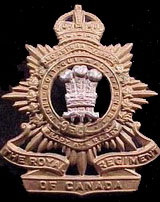
Close
this page

THE ROYAL REGIMENT OF CANADA
Description
Gules to a crown of cross pattées and fleur-de-lis gold set naturally, supported by a strip of ermine of the same, and strung with three silver ostrich feathers, their ends intertwined with a listel d azure gold border inscribed "ICH DIEN" in letters of the same, all surrounded by a garter of azure edged and buckled with gold, inscribed "HONI SOIT QUI MAL Y PENSE" in letters of the same, accompanied by the chief and at the tip of two azure listels inscribed "NEC ASPERA TERRENT" and "READY AYE READY" in gold letters, and on the two sides of natural autumn maple leaves, broaching on a gold diamond star topped with the royal crown in natural and supported by a listel of gules edged with gold inscribed "THE ROYAL REGIMENT OF CANADA" in letters of the same.
Symbolism
The badge is inspired by the badges of the "Royal Grenadiers" and the "Toronto Regiment", amalgamated in 1936 to form the regiment. The maple leaves represent service to Canada and the crown, service to the sovereign. The star, a traditional form of badge for infantry in the 19th century, is inspired by the badge of the Royal Grenadiers, while the garter, on which is inscribed the motto "HONI SOIT QUI MAL Y PENSE", is that of the very noble Order of the Garter.
The central element is taken from the badge of the "Toronto Regiment". During the Hundred Years War, Edward, the Black Prince, first prince of Wales (eldest son of Edward III), defeated the Earl of Luxembourg and King of Bohemia (eldest son of Henry VII, emperor of the Holy Roman Empire ), at the Battle of Crécy. After this battle, it is said that the prince adopted the three white ostrich feathers that were on the shield of his defeated enemy, as a badge of the designated heir to the crown. He also adopted the motto of the late king, "ICH DIEN" (I serve).
"THE ROYAL REGIMENT OF CANADA" is the name of the regiment. "NEC ASPERA TERRENT", the adage of the "Toronto Regiment", and "READY AYE READY", the adage of the Royal Grenadiers, are the adages of the regiment. The first adage comes from the old Allied regiment, "The King's Regiment", now the "Duke of Lancaster's Regiment", resulting from a fusion.